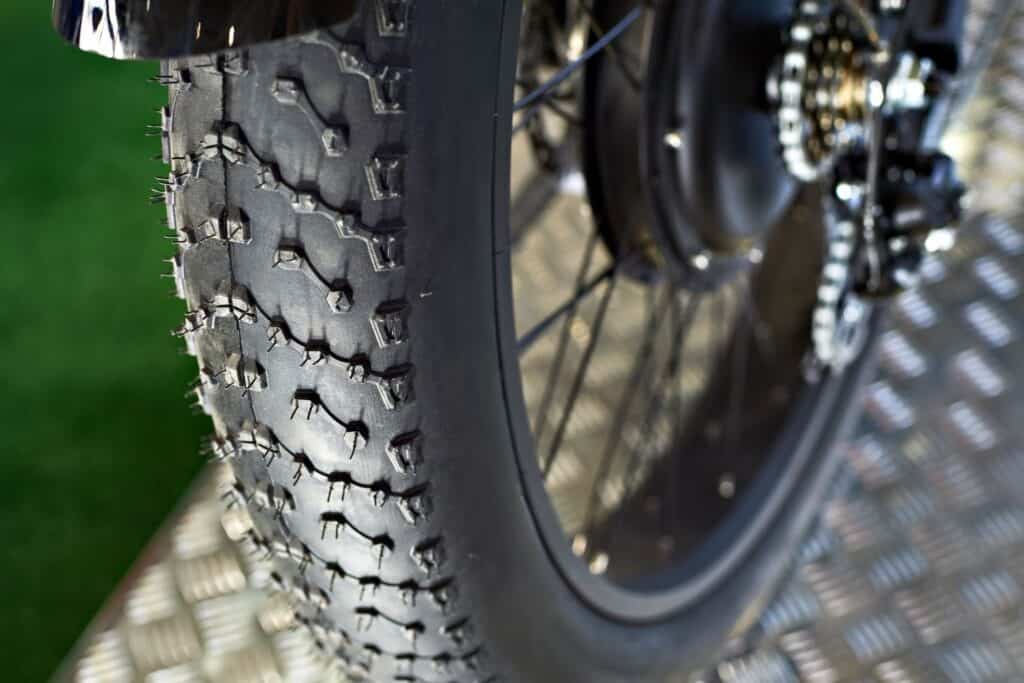Electric bikes have been making waves in the biking world, and you’ve probably noticed something unusual: their fat tires! It can appear somewhat comical at first, but the truth is that fat tires offer substantial benefits to e-bikes. So, why do e-bikes have fat tires?
E-bikes have fat tires because they can handle slick terrain and sandy beaches and are more comfortable when riding over bumps because they absorb rough terrain better. These 4” thick tires can also burn more fat since you pedal harder, with the thick treads also building balance and traction.
In this article, we will go more in-depth about why e-bikes have fat tires, their benefits, and a few drawbacks of this set-up.
What Is an E-Bike?
Electric bikes are a relatively new invention, but simple: just add an electric motor to a regular bike, and you have an electric bike. These versatile marvels boast automatic power or throttles that give you an extra boost of speed when you don’t want to exhaust yourself going up a steep hill or while traversing rugged terrain.
E-bikes are a handy way to commute or exercise, with varying assist levels available to give you the perfect level of electric motor assistance as needed during your bike ride. That’s why electric bikes are becoming popular amongst bike enthusiasts and fitness-minded people alike.

Why Use Fat Tires on an E-bike?
It can be deceptively easy to look at a fat tire e-bike and assume it’s exactly the same thing as a regular tire but bigger. But you’d be wrong. The massive surface area addition to the tires provides a wide array of benefits that give riders a completely different feel on the road, trail, sand or even snow.
Here are the reasons to use fat tires:
Fat-Tire E-Bikes Work On Any Terrain
Fat tires provide a lot of surface area that comes in handy during your rides. The thickness allows you to ride on sand, snow and ice, and marshy conditions more easily than with narrower tires. You also won’t find any issues dealing with slick and rainy conditions – fat tires give you complete control over your ride. With the assist setting cranked up, you’ll even notice speeds comparable to a regular bike.
Fat-Tire E-bikes Are Ideal For Beach Riding
Being able to go anywhere with fat tire e-bikes means that you can even ride on beaches! Beaches are a popular vacation spot or even a relaxing weekend oasis, but they usually involve sand everywhere, which makes normal bike riding almost impossible – not anymore! Fat tires give you the flexibility to ride on sandy beaches and take in the sights while you cruise.
Fat-Tire E-bikes are Comfortable Easy Riding
Fat tires require far more air than regular tires, which means they have more shock resistance than standard wheels. So, what does this mean for your bike ride? Well, those bumps, sticks, and holes in your way are better absorbed by the air in your fat tires. It doesn’t sound like much, but riding on an e-bike with fat tires is one of the most comfortable rides you’ll ever experience.
As a bonus, you can adjust the air pressure in fat tires to change where you get the support you need. Fat tires can go down to just 10 or 15 psi, where they’ll act more as cushions for rough terrain such as woods or hilly trails with uneven ground.
More Durable Than Skinny Tires
The sheer thickness of fat tires over skinny tires makes them very durable. Skinny tires have a reputation for cracking when they contact ice, but fat tires don’t seem to have this problem. The pure thickness of fat tires (usually around 4 inches or more) means you won’t be going through tires as you may with skinny tires.
Burn More Fat or Get more exercise with Fat-Tire E-Bikes
For the fitness-inclined, riding on fat tires will burn more calories than regular tires. Due to the extra surface area on the wheels, you have to pedal harder on asphalt or other flat and even surfaces. Depending on your assist setting, you can even those parts out, but you’ll leave it off if you’re interested in shedding a few extra pounds or getting more exercise.
Fat-Tire E-Bikes Bring Better All-Around Control And Balance
Because of increased tread and tire surface area, fat tires also offer more control and balance. This means you can make pinpoint accurate turns and maneuvers through the most unforgiving terrain like forest trails and even hilly, rocky mountains. This same surface area and tread give the cyclist more balance and a larger platform and comfort.
Electric Power Eliminates Fat Tire Drawbacks on E-Bikes
One of the common disadvantages of fat tires before e-bikes was that they made the bike heavy and cumbersome to ride for extended periods or long distances. With an electric motor’s inclusion, you can get the extra zip needed to keep your ride from becoming too tiring too quickly.
For this very reason, fat tires are making a huge comeback on e-bikes, taken advantage of by cyclists.
E-Bike Pedal Assist Provides Versatility
When riding on fat tires, it can be easy to tire yourself out, even on roads and other flat areas. When this occurs, you can simply switch up your assist setting to take the edge off your workout’s intensity and give you a chance to relax and breathe. Additionally, when you use it in offroad conditions, assist can provide you a significant and reliable speed boost.
For you exercise-oriented readers, riding an e-bike with fat tires offroad is an excellent way to work out – turning and other offroad maneuvers are a great way to build up your core muscles. As mentioned before, fat tires are harder to pedal on flat ground, which is where the assist shines.
The Drawbacks Of Fat Tires on E-Bikes
While fat tire e-bikes have some convenient benefits, like offroading and beach cruising capabilities, that doesn’t mean they’re without their drawbacks. Skinny tires have their place within the cycling world, as judged by their own unique advantages and popularity. It’s also true that many of the disadvantages of these tires are remedied by the electric motor. But that doesn’t completely fix them by any means.
Here are the negatives of fat tires on an e-bike.
Harder To Pedal
The primary drawback to fat tire e-bikes is that they’re hard to pedal, especially on flat ground where the entire tire is making consistent contact with the surface. The more tire that makes contact with the ground, the more resistance you’ll face while pedaling. The electric motor can indeed reduce or even eliminate this problem altogether, but if your battery is low and you’re exhausted, and you can’t charge, you may face some trouble getting back.
More Expensive
Fat tires are more expensive than regular tires – this shouldn’t be any surprise to experienced cyclers out there. This is because fat tires require specialty parts such as hubs, rims, tubes, and others. Fat tire bikes don’t typically have a suspension system either because the tires act as their own shock absorbers.
This expense goes up if you want to get a custom-built e-bike with fat tires, which many people do to customize its performance or try to get the bike down to a lower weight.
Hard To Find Parts For
When a part on a fat tire e-bike breaks or needs replacement, you have a bit of a journey on your hands, because the specialty components necessary to make these bikes run are more pricey and hard to come by than components for a skinny tire e-bike. While they’re gaining in popularity, skinny tire e-bike parts are easier to find at a low cost.
